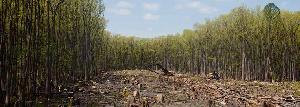Pembrokeshire Friends of the Earth - News
 Trecwn Biomass Power Station 27th August 2015
Trecwn Biomass Power Station 27th August 2015
Pembrokeshire County Council unanimously vote in favour of “Renewable” biomass power station at Trecwn
Is PembrokeshireCounty Council leading us into an new era of clean air and renewable energy? Alas no; the developer Valley Ltd, plan to install a 25MW power station to generate energy from biomass fuel, comprising a mix of virgin wood chip and /or pellets, with potentially a proportion of recycled / waste wood chip. The source of fuel is not determined but it is likely that initially the majority of the fuel would be delivered by ship and stored at Pembroke Dock, then transported to the site at Trecwn, the old military base near Fishguard by road.
Valley Ltd. estimate that there will be 53 HGV/106 two way journeys a day (one with an empty truck). As most of the fuel would be imported via Pembroke Dock, it would be more environmentally acceptable to site the electricity generating plant closer to the town and avoid these journeys and to enable the waste heat to be used in existing industrial facilities.
The company admits that the power station will only be 26% efficient, 74% of the energy in the fuel will be wasted. This will not help to cut carbon dioxide emissions; it’s more like fiddling while Rome burns.
The net carbon benefit of biomass electricity generating stations is questionable as government guidelines
do not include direct emissions from the stack, assuming that the process is carbon neutral. One tonne of dry wood burnt in a power station emits 1.8 tons of CO2 into the atmosphere. Studies show that burning trees can result in higher greenhouse gas emissions than burning coal.
Last year, 60 eminent US scientists wrote a letter to the UK Secretary of State for Energy and Climate Change warning him that, “burning trees to produce electricity actually increases carbon emissions compared with fossil fuels for many decades and contributes to other air pollution problems”.
As well as releasing greenhouse gas emissions, burning wood produces other pollutants, including particulates, nitrogen oxides, and polyaromatic hydrocarbons (PAHs), which pose a threat to human health and ecosystems. It is likely to exacerbate the problems for people used as it may contain chemicals including dioxins, arsenic, lead and mercury. Burning waste wood also diverts it from recycling by the wood panel industry.
The developers state that there is the possibility of rebuilding the old railway line running to Fishguard to transport the wood. They may be able to attract more industry to this area to make use of the waste heat produced, so making Combined Heat and Power which is much more efficient could be possible in the future. Local farmers could grow biomass crops to supply the power station in the future, but for now they would be importing wood pellets from virgin forests in the States Canada or Latvia.
The government classes biomass fuel (i.e. wood,energy crops and farming and forestry waste) as a renewable and supports its use through the Renewables Obligation, which provides financial subsidies for burning wood. FoE is calling for the government’s ambitions for bio energy to be scaled down and capped at a level that ensures supplies can be sourced sustainably and domestically.
https://www.foe.co.uk/sites/default/files/downloads/felledfuel46611.pdf
The public health impact of woodburning power plants:
http://www.biofuelwatch.org.uk/2014/biomassaqbriefing/ .
US paper discussing the air quality impacts of biomass electricity: http://pfpi.net/airpollution2 .
Evidence presented at a Congressional hearing in the US:
http://www.saveamericasforests.org/Forests%20%20Incinerators%20
%20Biomass/Documents/Briefing/index.html .








